Moving on, stepping down, retiring; none of these are phrases the Talking Mats team were allowed to use over the past few months as Lois Cameron (outgoing Director of Talking Mats) edged closer to the 31st of March 2023. Instead, Lois termed her switch from Director as ‘changing gear’; a chance to go at a pace that would let her take in a bit more of life’s scenery. Lois has been with Talking Mats since the very early days with Joan Murphy and moved from research in the University of Stirling’s Psychology Department to the ‘incubator’ set up for new businesses on the University’s Enterprise Park. Here she reflects on some aspects of her time at Talking Mats, her hopes for the Enterprise and her plans for all that spare time.
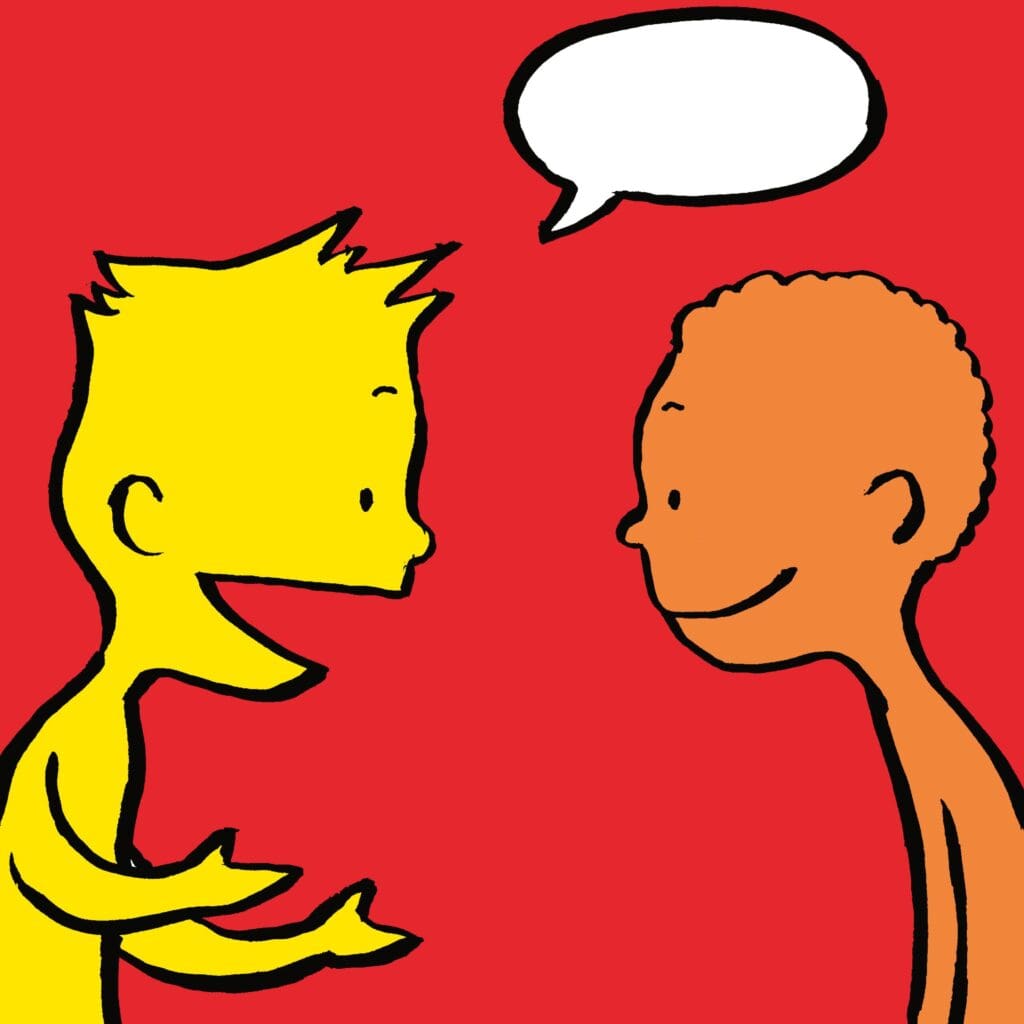
What was it about Speech and Language Therapy that appealed to you?
I think it was the mix of language and psychology and medicine , the fact that it drew on different strands of learning and that it was with people. At 18 you never really know what you’re getting into, I was just really lucky that I chose something that I have really loved all my life.

Moving away from the NHS was a big step, what excited you about being part of Talking Mats?
I found a shocking statistic that it takes on average 17years for an idea that had been proved in health research to get put into practise. That’s a long time. Through our research on Talking Mats we knew we had a really effective way of getting people to express their views and be included. We investigated different (business) modes and a Social Enterprise was really going to allow us to focus on knowledge transfer. It would give us the flexibility to work across other sectors because this wasn’t just about health, supporting effective communication is important in all sectors e.g social services, education , other 3rd sector organisations, and we needed a business model that could be much more fleet of foot than you ever could be in a statutory organisation.. Setting up Talking Mats as a social enterprise was the vehicle for getting the research into practise.

Are there any stand-out moments for you from your time at Talking Mats?
The Scottish Enterprise Edge Award – we were the first Social Enterprise to win this award. It was developed to support businesses in Scotland, not specifically Social Enterprises, but as a Social Enterprise we won it and on a number of levels that had a huge impact on me. It said that Talking Mats as a business was taken seriously and it said ‘you’re not a therapist anymore, you’re a business woman’, it also said to me that they were taking Social Enterprise seriously as a way of doing business. So that was special.
My standout training stories are when I’ve worked with people with Learning Disabilities. There is something empowering about enabling people to grow and I feel my work with the National Involvement Network did that, training people with Learning Disabilities to become Talking Mats listeners and going on to support them to put Talking Mats into practise.

If you had a magic wand, what resource would you like to create?
I’ve always used Talking Mats in my business planning so the whole area of business development is one that interests me because communication is often the problem in businesses. If you analyse what goes wrong in business at the heart it is often communication and getting people to articulate that safely is hard, so I think that’s the resource that I’ve never had the time to create. I am doing some business mentoring with people running social enterprises now and using the framework and it is really powerful.

What do you wish for Talking Mats moving forward?
Stability, growth, a team that continues to work together with a variety of skills so that it still draws from different viewpoints and I wish it fab ways of getting the message across that actually using TM makes a difference and has a huge impact on peoples’ lives.
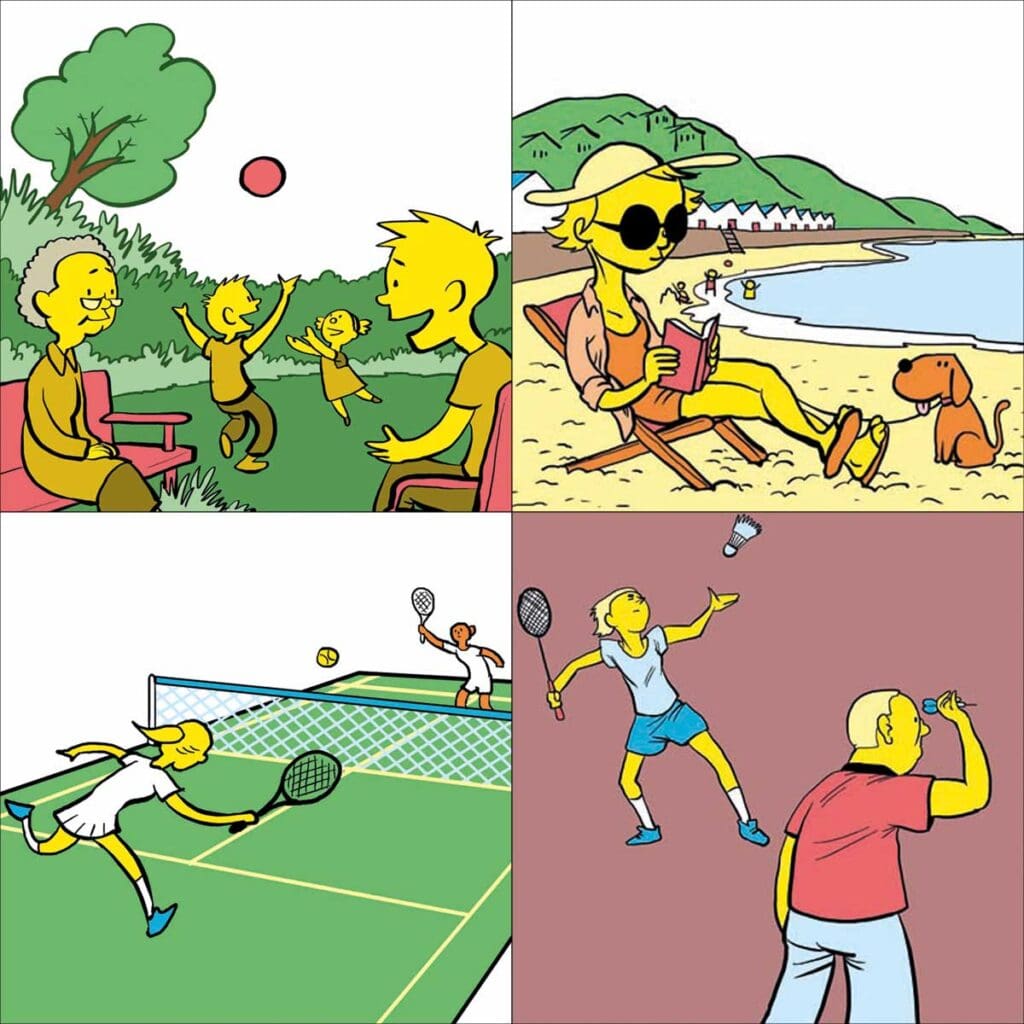
What plans do you have to fill all your spare time?
Walking, tennis, writing, learning Spanish, my singing group, yoga, spending time with friends and family . I’ve discovered I can make fabulous chocolate and tahini brownies which went down well at a tennis match recently. May is my month to walk the John Muir Way.
Final thoughts?
I’m really delighted Margo is taking over as the new Managing Director and the new team has opportunities to support her and grow Talking Mats.
Thank you to Lois for answering these questions and the team at Talking Mats wish you all the best for the future.
Thank you to Lisa Chapman,Lead Speech and Language Therapist at Bee U: Child & Adolescent Mental Health Services, Midlands Partnership NHS Foundation Trust, who has shared her thoughts about the new sensory resource, sharing what it means to her both professionally and personally. Use these links to read more about the resource and our giveaway offer and to book directly.
A personal and professional journey intertwined.
Communication has always been one of my passions. As a languages teacher I was struck by the speech, language and communication needs (SLCN) of my students and this led me to retrain as a Speech and Language Therapist (SLT). As a parent I saw how my youngest son struggled to communicate his needs and how others struggled to understand him across different environments. He now has a diagnosis of Autism and the experiences we have had together were the start of my journey to explore Sensory Processing.
Sensory Processing, Sensory Integration and Neurodiversity.
Sensory processing is something we all do, it is how we make sense of the world around us using our 8 senses. These websites offer a good general overview of our senses and sensory processing;
- Understanding Sensory Processing and Integration in Children (sensoryintegrationeducation.com)
- Free online sensory processing course for teachers, assistants and parents (griffinot.com)
How this information is then dealt with is referred to as ‘Sensory Integration’; ‘the processing, integration and organisation of sensory information from the body and the environment’ (Schaaf & Mailloux, 2015, p5).
From my growing personal interest came ideas on how sensory processing and integration overlapped with my professional life as an SLT. Hooked, I enrolled on the Sensory Integration Masters course with Ulster and latterly Sheffield Hallam University. I completed my Diploma in 2021 and hope to complete my Masters dissertation later this year.
I love that I have been able to weave my ‘lived’ experiences into my professional development. These experiences continue to overlap. Most recently, this has involved exploring the concept of Neurodiversity, “the infinite variation in neurocognitive functioning within our species” (Walker, 2014a). Walker clarifies that the neurodiversity paradigm has three fundamental principles
• Neurodiversity is natural and valuable. We are stronger because of our diversity.
• There is no one ‘right’ way to process information. There is no such thing as a ‘normal’ brain.
• It is important to acknowledge social power dynamics exist in relationship to diversity. Walker (2014b) reminds us to ‘check’ our privilege. This will frequently involve moving out of our comfort zone (Murphy, 2022).
This paradigm has become a core framework for me as both an SLT and a parent. It helps me make sense of variations in communication and sensory experience, to reframe these as differences, not deficits. Understanding my son’s sensory processing has helped me see the world through his eyes allowing new spaces for communication and different conversations. It has helped to reduce the Double Empathy gap (Milton, 2012).
I am equally aware of the impact of environments. Luke Beardon’s (2017) ‘golden equation’, one I quote often, aptly summarises this. “Autism + Environment = Outcome”. Environment here includes identity, the sensory environment, other people and society (Beardon, 2022). The value of having a clearer understanding of your identity and needs is also context dependent, ‘relational’ (Chapman, 2021). You, and others around you, may have great insight into how your body and mind work, but this can only go so far. If no one is listening to you, and environments in their broadest terms are set up to be against you, are ‘low-functioning’ (Patten, 2022, p.8), it is harder to achieve positive and authentic outcomes.
For my autistic son, education settings have sadly often been ‘low-functioning’ environments, placing an immense toll on his sensory processing, communication and ultimately on his emotional well-being. The impact on us as parents has been no less challenging, coping with multiple exclusions from multiple placements. I have equally seen the power of restorative, ‘high-functioning’ environments (Patten, 2022, p.12) that enable him to be the best he can be: environments that offer success, building on his interests and abilities.
The very nature of neurodiversity suggests that we all process sensory information differently. A better understanding of individual sensory experiences gives more information that we can use to create and advocate for ‘high functioning’ environments for everyone, and achieve equity. A crucial first step in neurodiversity affirming practice is respecting an individual’s ‘epistemic authority’ (Chapman & Botha, 2022). To listen without prejudice, and not to enforce that we know best, just because of our position.
With this as my personal and professional ‘framework’ I welcomed the opportunity to trial the Talking Mats resource; Me and My Senses and my final thoughts are around using it with my son.
My personal journey continues; learning and growing
As his mum, and as an informed professional, I felt that I already knew my son’s sensory profile, that I could predict what some of his answers were going to be. He had also already had a full OT-ASI assessment. I came to this as an exercise in ironing out snags, not primarily one of personal learning. I couldn’t have been more surprised by the wealth of new information I came away with, after using the mat with him.

My most important learning was around the significance of smell for my son. Using the mat gave him the space and opportunity to share his insights into smell that I had never really appreciated before. What’s more, this ‘opening up’ extended beyond the time we were using the mat. For the rest of the day he continued to refer to his mat, adding further examples and anecdotes about ‘smell’ as a fundamental sense for his well-being. The mat had provided a safe space for exploration, connection and communication beyond its physical presence. It was a humbling, but also precious experience. It illustrated beyond doubt the importance of listening, but also the immense privilege of opening up and sharing a space that facilitated my son’s voice to be heard.
Until now, few tools have captured the lived ‘sensory’ experiences of children and young people. The Talking Mats ‘Me and My Senses Resource’ meets this need. It places an individual’s voice as central, acknowledging and facilitating autonomy and agency. As such, it is an invaluable tool to anyone wishing to explore sensory processing in a neurodiversity affirming way.
References
Beardon, L., (2017, July). How can unhappy autistic children be supported to become happy autistic adults? https://blogs.shu.ac.uk/autism/files/2017/07/How-can-unhappy-autistic-children-be-supported.pptx
Beardon, L. [@SheffieldLuke]. (2022, December 11). Autism + environment = outcome; environment could include: autistic self (e.g. understanding of self); others in that environment; the sensory. [Tweet]. Twitter. https://twitter.com/SheffieldLuke/status/1601894447721111552?s=20&t=HmyywdI4gDSrDJ1BggtF3w
Chapman, R. (2021). Neurodiversity and the Social Ecology of Mental Functions. Perspectives on Psychological Science, 16(6), 1360–1372. https://doi.org/10.1177/1745691620959833
Chapman, R., & Botha, M. (2022). Neurodivergence-informed therapy. Developmental Medicine Child Neurololgy. 00: 1– 8. https://doi.org/10.1111/dmcn.15384
Milton, D. E. M. (2012). On the ontological status of autism: The “double empathy problem”. Disability & Society, 27(6), 883-887. https://doi.org/10.1080/09687599.2012.710008.
Murphy, K. (2022). Neurodiversity in the Early Years. Neurodiversity & ableism reflection tool. https://assets-global.website-files.com/5f903cbab2ae71f26cf02400/638a04bcc5a15c6fda2c02b1_AUDIT_Kerry%20Murphy.pdf
Patten, K. K. (2022). Eleanor Clarke Slagle Lecture—Finding our strengths: recognizing professional bias and interrogating systems. American Journal of Occupational Therapy, 76, 7606150010. https://doi.org/10.5014/ajot.2022.076603
Schaaf, R.C. & Mailloux, Z. (2015). Clinician’s guide for implementing Ayre’s sensory integration: Promoting participation for children with autism. American Occupational Therapy Association: Incorporated.
Walker, N. (2014a). Neuroqueer: The writings of Dr. Nick Walker. Neurodiversity: Some basic terms & definitions. https://neuroqueer.com/neurodiversity-terms-and-definitions/
Walker, N. (2014b). Neuroqueer: The writings of Dr. Nick Walker. Neurotypical psychotherapists & autistic clients. https://neuroqueer.com/neurotypical-psychotherapists-and-autistic-clients/
After many months of work the new Talking Mats sensory resource; Me and My Senses is reaching the final phase and registrations open on Friday 31st March for our launch seminar. This blog gives an overview of what’s in the resource and our guest blog to be published on Friday is a powerful story of professional and personal learning with ‘Me and my senses’ playing a pivotal role.
The resource will aim to enable children and young people who have speech, language and communication needs (SLCN) and sensory integration difficulties to have a voice in their therapy assessment, planning and intervention. To find out more about the funding and development for this project please read the earlier blog here. It is also aimed at supporting all practitioners, regardless of their level of sensory integration training, to gain an individual’s voice of their ‘lived’ sensory experiences, needs and challenges.
It is divided into the following topics:
- My Spaces & Things I Do
- My Senses 1: Proprioception & Interoception
- My Senses 2: Vestibular
- My Senses 3: Taste, Smell, Hearing, Seeing, Touch
Use of the resource may contribute to sensory integration evaluation but does not replace a full sensory integration assessment, however it may equally work as a stand alone-tool. We hope that professionals from healthcare,education, in both mainstream and specialist settings, as well as colleagues in social care will value this resource.
Talking Mats is hosting an online seminar to introduce the resource and we have 50 sets to give away for free to the first 50 people who register for the seminar and are already Talking Mats trained. Registrations open on Friday.
We are always keen to support other Social Enterprises, and would like to introduce our community to Communication Inclusion People, a new enterprise with a big vision. Find out a little bit about them and how to contact them.
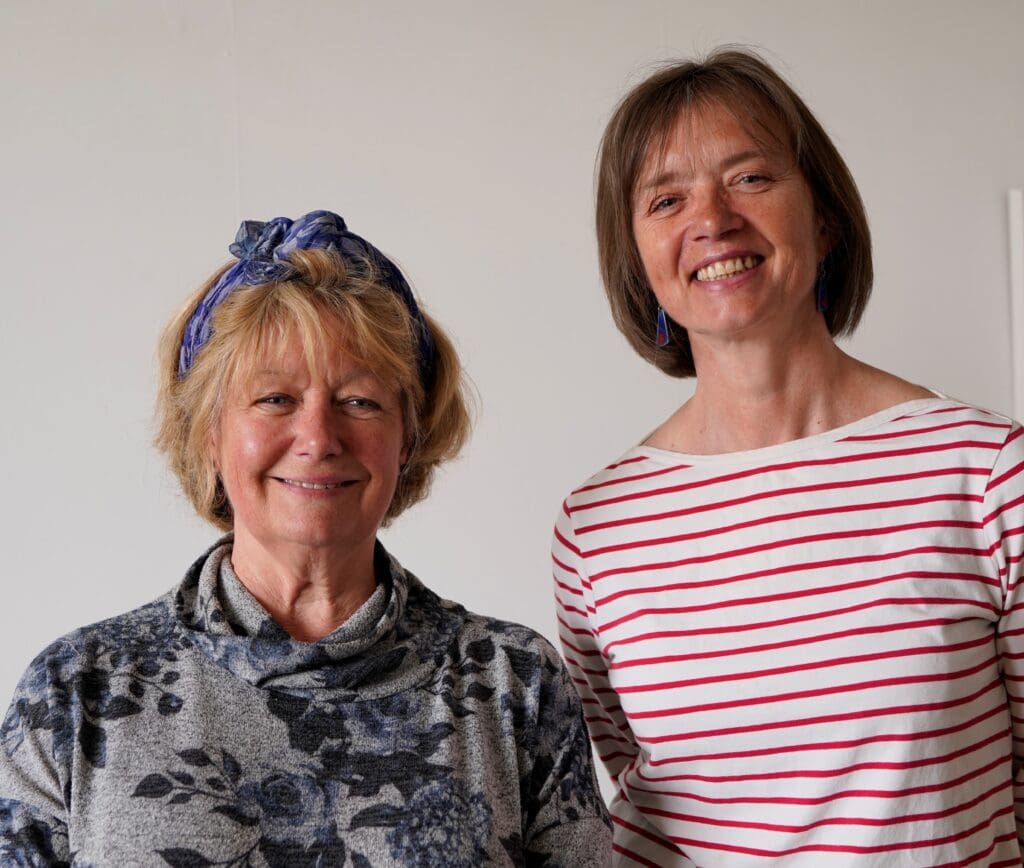
Hello – we are Communication Inclusion People. We are a new Scotland based social enterprise aiming to change the world.
Our mission is to work with others to create communication equality through universal adoption of inclusive communication best practice.
Talking Mats is a brilliant way of making communication about specific topics inclusive. We recommend it to many people. Most recently it was one of the resources we recommended in the Place Standard Tool Inclusive Communication Toolkit | Our Place
However, people need to understand information to find out an organisation even exists. We support organisations to be communication inclusive for their clients and staff – from the first hello to the last goodbye. Our work therefore compliments Talking Mats well. We help organisations to check, plan and develop their inclusive communication practice in everything they do. We always co-produce with people who communicate in different ways.
To find out more please contact us in the way you find easiest





In the first of 2 blogs on Selective Mutism, Vanessa Lloyd of Birmingham Women’s and Children’s NHS FT describes using Talking Mats to give a young boy the opportunity to communicate at a time when talking was too hard.
Using Talking Mats with a primary school aged child with developmental Selective Mutism
Selective Mutism is a form of social anxiety characterised by stark differences in how a person communicates in different situations. There is also acute awareness of everyone around them who may be listening, either intentionally or accidentally. In Education settings Selective Mutism often become apparent at times of transition and teachers often describe a very different child to the one a parent knows at home. As a school therapist I have the job of finding the puzzle pieces and bringing them together in a way that home and school can understand. I have found the Talking Mats approach to be very useful when working in this area. Here’s an example;
I recently took a referral for ‘A’ who is 6 years old:
Main points from school:
- Joined 12months ago
- Not spoken at school in those 12 months
- Staff felt they didn’t know him
- Staff assumed he was happy not joining in
Main points from parents:
- Aware he is quiet in school
- This is who he is and he has been like this since starting Nursery
My observations indicated Selective Mutism;
- his body language indicated anxiety in situations where he was expected to speak or interact
I needed a way to feedback this anxiety to staff and for A to be heard without using his voice. After building a rapport with him I introduced Talking Mats and offered him the opportunity to engage
Getting Started
Using the Primary Communication Rating Scale (Johnson & Wintgens, 2016) as a basis, combined with an image system he was familiar with, I planned the symbols needed to support the conversation and set out the expectations for the activity. Fundamentally, I made it clear that he did not have to talk to me to participate.
How it went
The school environment.

As anticipated, he made his feelings instantly clear about the activities where he was required to talk, rapidly sorting them into ‘unsure’ or ‘don’t like’.
What was less expected was how relaxed his body language became, particularly when I suggested showing his class teacher. It was as though he knew that there was some power behind his arrangement of these symbols and he was ready to embrace it.
Follow up
Talking at home.
Having fully grasped the potential of the task, this young boy set to work answering my questions through careful consideration and placement of symbols. The same questions that would otherwise spiral him into a freeze or flee response were now being answered with a newfound command of the situation. He had things to say, things he wanted people to know, and in that moment, he had a way of doing this

Taking it forward:
Showing the child’s perspective provided a powerful way of highlighting to school the misguided assumptions that had been made about his feelings and attitudes towards talking. The Talking Mat conversations opened the discussion about the importance of Selective Mutism intervention and created a platform for the child to be involved and be heard. He was a valued contributor in an environment which was previously inaccessible for him.
Decisions, decisions. Few people can make a snap decision without weighing up options. This blog describes how the authors looked further into this as part of the Talking Mats process and discovered it is actually a crucial part of thinking and communicating. A good old Scots word, ‘Swither’ sums it up perfectly. Thank you to Joan Murphy, Norman Alm and Sally Boa members of the Talking Mats Research Network for this fascinating blog.

The Talking Mats Research Network currently includes 47 people from 11 different countries and meets regularly on Zoom. One of its subgroups is looking at how Conversation Analysis can help us to understand how and why Talking Mats works.
The project:
Comparison of the interactions of a man with severe expressive aphasia having two conversations on the same topic – one without Talking Mats and one with Talking Mats. The topic in both cases was how he was managing getting around.
What we found:
- Without Talking Mats: there were more vocalisations in the conversation, but they were less intelligible and there was more confusion between the thinker and the listener.
- With Talking Mats: there were more silences but this was an obvious part of the thinker’s response and by examining how he handled and placed the cards we got a clearer sense of his thinking and intellect.
Further analysis:
- We employed Conversation Analysis techniques to look the session where Talking Mats was used.
- A significant feature which emerged was that, with Talking Mats, the thinker often hesitated while thinking where to place the card, moving the card back and forth before finally settling in one position.
- To explain this, we borrowed the Scottish word ‘swither’. The dictionary definition of swither is ‘to be uncertain as to which course of action to choose’.
Our thoughts / conclusions:
Following discussion, we now feel that swithering, when we move our words or thoughts about in our brain to help us make up our mind, is an important positive feature of conversation. However, a person with a communication disability may find it hard to give a nuanced response and/or we often expect people with a communication difficulty to give a clear ‘yes’ or ‘no’ response. It can be seen as a failing if they appear uncertain, whereas swithering should be regarded as a positive and crucial aspect of how we think and communicate.
One of the many reasons why Talking Mats is successful is that it allows people to ‘swither’ by giving them permission to be unsure and gives them access to a more modulated response.
If you are interested in carrying out reseach in Talking Mats or using Talking Mats as part of your research you can read more here or contact us on info@talkingmats.com
This new resource aims to enable children and young people who have speech, language and communication needs (SLCN) and sensory integration difficulties to have a voice in their therapy assessment, planning and intervention. To find out more about the funding and development for this project please read the earlier blog here.
The project is picking up pace and we are now in the pilot/feedback phase. The resource will be launched in April 2023 and as part of this final launch/sustainability phase, there will be an opportunity for practitioners working with children and young people with sensory needs and communication difficulties to access a free bespoke Talking Mats Foundation Training course.
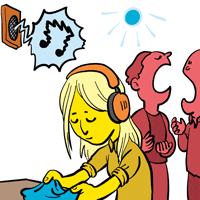
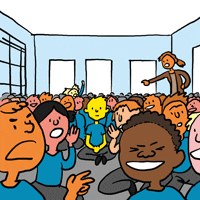

The training:
We are offering non-Talking Mats trained practitioners working in this field the opportunity to apply for a free Talking Mats Foundation live online training course, taking place in May 2023. This training will focus on applying this resource using the Talking Mats key values and process. Training will include a free copy of the resource.
What is involved?
Each course comprises of 2 half day sessions delivered via Teams:
Option 1: Session 1: Wed 10/05/23 9.30 – 12.30
Session 2: Wed 24/05/23 9.30 – 12.30 (including video reflection/feedback)
Option 2: Session 1: Thurs 11/05/23 9.30 – 12.30
Session 2: Thurs 25/05/23 9.30 -12.30 (including video
reflection/feedback)
You will be asked to complete a video of yourself carrying out a Talking Mats session ready to present in Session 2 – this can be up to 5mins long (edited if needed) and ideally involving use of the sensory set, however we are aware that due to consent/privacy issues you may need to do the session with a friend/family member/ colleague and so can provide you with our leisure-home set if required.
After training participants will need to:
- select 3-5 children or young people from your caseloads to use the resource with.
- provide written feedback (a template for this feedback will be provided) by the end of June 2023 at the latest.
The children or young people you select will need to have recognised communication difficulties as well as sensory integration/processing difficulties, and be able to access Talking Mats:
Selection criteria
• Aged between 5-18
• Comprehension skills/understanding at 2 key word level or above
• No/limited visual impairment.
Next steps:
If you are interested in applying for a free training place, please contact Laura Holmes via email at laura@talkingmats.com, by Wednesday 01/03/23. Please include details of your preferred training option/dates (Option 1 or Option 2) and also of your role/ organisation and confirming that you would be able to use the resource post-training, as described above. We will only be accepting one application per organisation.
There are only 24 places available over the 2 training options so please get in touch quickly if you are interested in this opportunity.
Kim Stringer, Director of the Charity Vegetarian for Life, describes her thinking behind this new resource and asks for volunteers to help test it out.
I first had a Talking Mat conversation at the Alzheimer Scotland conference in 2019 and was struck by the way a picture of my likes and dislikes emerged. I wouldn’t have collected all these ideas together in a spoken conversation and I immediately thought this would be a great tool to use to explore an issue that Vegetarian for Life was becoming increasingly aware of.
We support older vegans and vegetarians, and those who care for them, and we had been hearing about some vegetarians with dementia who were asking for meat. It seemed unlikely to us that people who had chosen to be vegan or vegetarian because of their beliefs would suddenly reconsider these views. Staff and families were facing a dilemma and I thought Talking Mats would be a great tool to explore food preferences and perhaps help to find out if a person was genuinely asking for meat.
After initial conversations with Talking Mats we had a seminar to gather other team members’ thoughts, and we began to create the resource. We decided what topics we wanted to cover, how these could be grouped, and what top scales would work.
Dietary Choice

Not all vegetarians like to eat vegetables or meat replacement products and this topic is designed to allow people to express their food preferences. Meat and fish options are included in this topic to help get a reliable picture of a person’s beliefs. When considered along with the conversation arising from the Values topic this gives the opportunity to get a fuller understanding of someone’s motivations. Suggested top scale to use:
Want to eat / sometimes want to eat / don’t want to eat
My eating experience
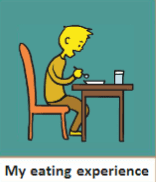
This topic helps explore if someone is happy with their current situation. Some of the symbols cover general subjects, while others are more specifically vegetarian- or vegan-focused. We included things such as celebrations and events. Vegetarians and vegans will want to enjoy these too but may feel excluded if offered something like a salad while others eat burgers. Suggested top scale to use:
Happy / so-so / not happy
Values. Lifestyle
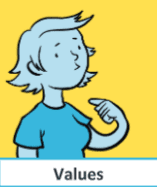
People adopt vegetarian or vegan diets for different reasons and these topics address the reasons behind this choice, and consider the wider lifestyle implications, not just diet. For example someone following a plant-based diet for health reasons may feel differently about toiletries and cleaning products which may have been tested on animals than someone for whom veganism is a philosophical belief. These topics help build a picture of the reasons behind the lifestyle preferences. Suggested top scales to use:
Values: very important / quite important / not important
Lifestyle: want / don’t mind / don’t want
We hope that the conversations generated by the mats will allow care providers to get to better know the person who is receiving care. They may also foster a greater understanding of vegetarianism and veganism.
For more information about good practice when catering for vegetarians and vegans living with dementia, please see Vegetarian for Life’s Memory Care Pledge.
This resource is now in the testing phase and we are looking for volunteers. If you think you can use the resource at least twice between now and the 17th of March please email info@talkingmats.com describing the setting(s) and clients you might use the resource with. We require up to 6 people for this phase.
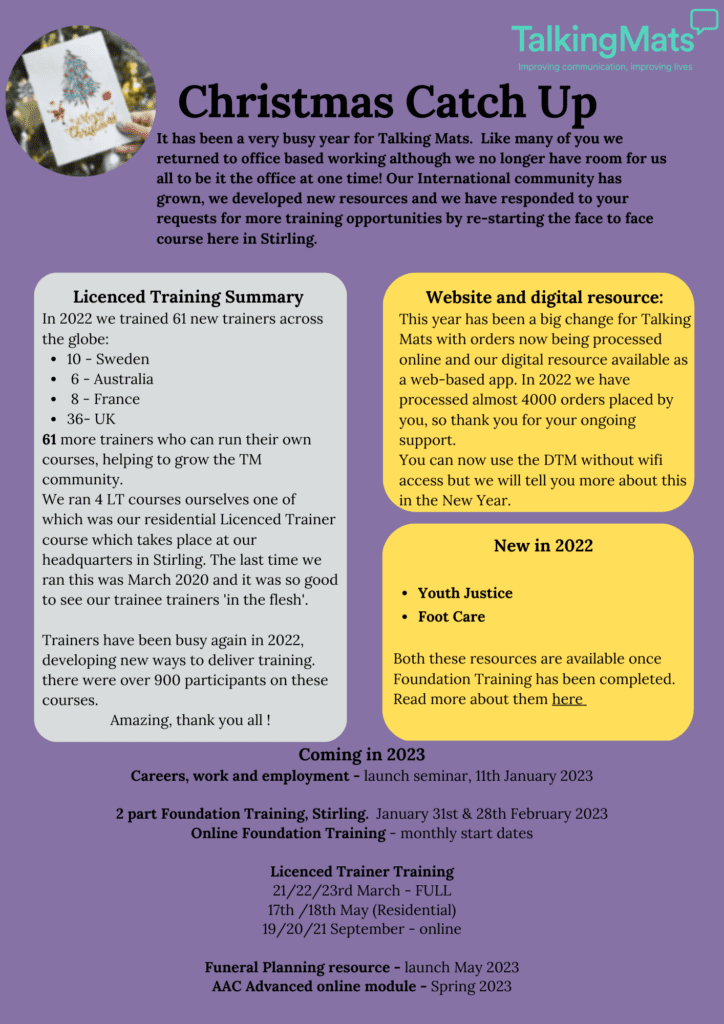
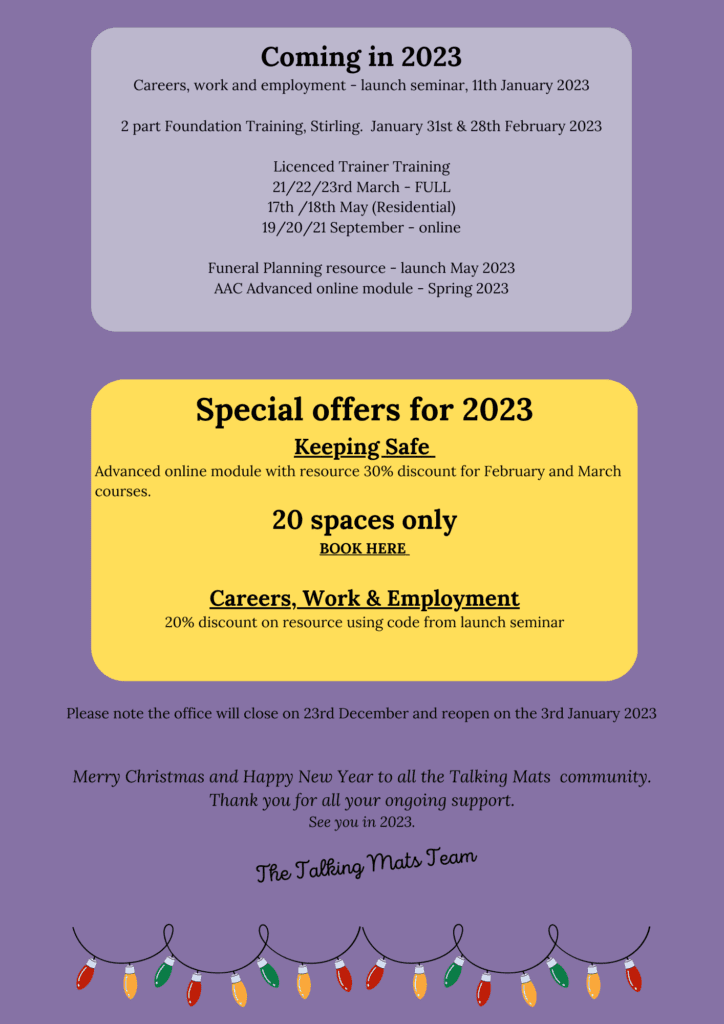
On the 11th of January 2023 the new Talking Mats resource, Careers, Work and Employment will be launched with an online seminar. Alison Cuddington, Speech and Language Therapy Team Leader with Autism East Midland and one of our Licenced Trainers has written about her involvement in developing the resource with staff and students at Sutherland House School.
The context
I work as a Speech and Language Therapy Team Leader at Sutherland House School, a specialist school run by Autism East Midlands. Myself and the team worked on the development of a new resource with Talking Mats looking at providing students at the school the opportunity to communicate their opinions on topics relating to careers.
Careers provision in England is driven by the 8 benchmarks outlined in the 2014 Gatsby ‘Good Career Guidance report’. These are:
- A stable careers programme
- Learning from career and labour market information
- Addressing the needs of each pupil
- Linking curriculum learning to careers
- Encounters with employers and employees
- Experiences of workplaces
- Encounters with further and higher educations
- Personal guidance
Our school was looking to provide careers and education guidance in a way that followed this framework whilst supporting the communication needs of our students. The Careers, Work and Employment resource does this. The complete resource supports careers advisors to work with students in meeting Benchmark 8, ‘Personalise Guidance’, however other benchmarks are more specifically met through the 3 topics:
- Readiness to work
- Skills
- Preferences
Readiness to work

This topic asks the thinker (our students) to consider aspects of health, sensory stimuli, communication, supports etc when thinking about the workplace. Asking students to reflect on these will help them explore appropriate work opportunities, see reasons to engage in activities, and work on areas that are a challenge to their future aspirations. This will enable students to be signposted appropriately and participate in building a careers programme developed around their specific profile (Benchmark 3).
Skills

This topic looks at how a student perceives their own skill set. I found the flexibility of this topic reflected several of the Gatsby benchmarks. For staff, understanding if a student can accurately appraise their own skills will help them amend the careers programme accordingly (Benchmark 3)
My experience has shown that students do not always link their current learning to future employment opportunities. Using this topic allows the introduction of conversations around skills; reflection on strengths and who to approach for help with a skill etc (Benchmark 4)
Thinking about what skillsa student might want to use in a job will help staff attange work encounters/ experiences that are relevant. This can be revisited following a work encounter or experience to help find out if the specific skills were applicable and indeed remain important for an individual after experiencing them in the workplace. (Benchmark 5,6)
This topic also has potential to compare staff / student views on an individual’s areas of strengths and those needing development. Often students do not see the potential that teachers do and this is important feedback.
Work preferences
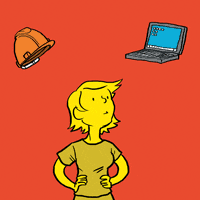
This topic considers aspects of a job that may or may not be important to an individual; for example being self-employed or working as part of a large company as well as life values. Knowing these preferences allows staff to arrange appropriate work experience placements. Carrying out a mat pre and post work placement will help demonstrate how important these preferences are to a student (Benchmark 6)
For anyone who missed our launch seminar Click Here to find a recording of the session
 Online training login
Online training login 



